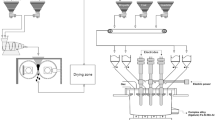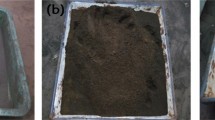Abstract
IN the course of experimental work on the deposition of carbon in the brickwork of blast furnaces (deposition which may cause the disintegration of the bricks), it has been found by electron micrography that the carbon is deposited as minute vermicular growths which can penetrate considerable thicknesses of brickwork. The carbon is formed by the interaction of carbon monoxide and iron oxide in the so-called iron-spots in the brick. It has been found possible to reproduce this reaction in the laboratory by exposing samples of brick containing iron spots to the action of carbon monoxide at an optimum temperature of about 450° C. Moreover, a similar form of carbon growth is observed if iron ore, magnetite or any form of iron oxide is substituted for the brick samples.
This is a preview of subscription content, access via your institution
Access options
Subscribe to this journal
Receive 51 print issues and online access
$199.00 per year
only $3.90 per issue
Buy this article
- Purchase on Springer Link
- Instant access to full article PDF
Prices may be subject to local taxes which are calculated during checkout
Similar content being viewed by others
Author information
Authors and Affiliations
Rights and permissions
About this article
Cite this article
DAVIS, W., SLAWSON, R. & RIGBY, G. An Unusual Form of Carbon. Nature 171, 756 (1953). https://doi.org/10.1038/171756a0
Published:
Issue Date:
DOI: https://doi.org/10.1038/171756a0
This article is cited by
-
The effect of copper on the multiple carbon nanofilaments growths by the methane decomposition over the oxidized diamond-supported nickel–copper bimetallic catalyst
SN Applied Sciences (2022)
-
A review of helical carbon materials structure, synthesis and applications
Rare Metals (2021)
-
Perversions with a twist
Scientific Reports (2016)
-
Structures and properties of diamond-like phases derived from carbon nanotubes and three-dimensional graphites
Journal of Materials Science (2015)
-
Systematic review of catalyst nanoparticles synthesized by solution process: towards efficient carbon nanotube growth
Journal of Sol-Gel Science and Technology (2015)
Comments
By submitting a comment you agree to abide by our Terms and Community Guidelines. If you find something abusive or that does not comply with our terms or guidelines please flag it as inappropriate.



